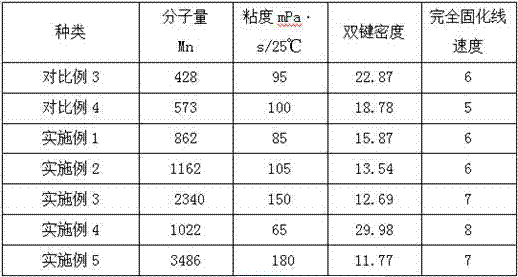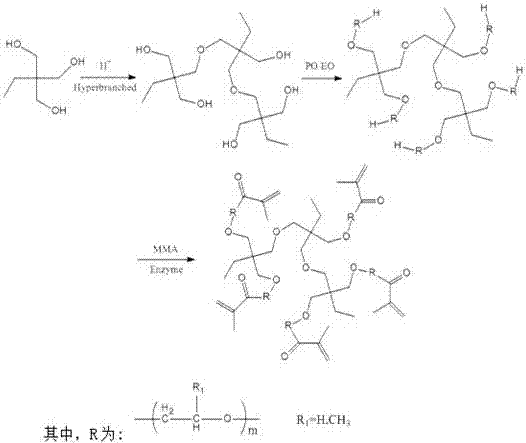A kind of low viscosity (branched) polyether acrylate and its preparation method and application
A technology of polyether acrylate and acrylate, applied in low-viscosity (branched) polyether acrylate and its preparation, UV inkjet, 3D printing, and leather finishing, which can solve the problem of catalyst residue product quality, Cost and environmental adverse effects, slow curing speed, large molecular weight and other issues, to achieve the effect of safe and non-toxic raw materials, fast curing speed, and fast curing rate
- Summary
- Abstract
- Description
- Claims
- Application Information
AI Technical Summary
Problems solved by technology
Method used
Image
Examples
Embodiment 1
[0038] Example 1 Polyether acrylate 1
[0039] A kind of polyether acrylate and preparation method thereof, comprises following two steps:
[0040] a. Transesterification reaction: Take 400g polyether triol (Mn≈700, Dow VOANOL 2070), 343.2g ethyl acrylate, 1.2g trinonylphenyl phosphite, 0.2g 2,6-di-tert-butyl Base-4-methylphenol, after uniform dispersion, add 5g of immobilized enzyme Novozyme 435 and 0.1g of lanthanum dodecylsulfonate, stir and react at 40°C for 24h;
[0041] b. Purification treatment: After filtering the mixture obtained in the previous step, the filtrate was subjected to vacuum rotary evaporation, and the ethanol and excess methacrylic acid generated by the reaction were removed to obtain 490.2 g of transparent and colorless esterified product (solid content 99.2%, viscosity 85 mPa ·s / 25℃, the esterification rate (based on polyether polyol as the base substrate, the same below) is 97.4%).
Embodiment 2
[0047] Example 2 Polyether acrylate 2
[0048] A kind of polyether acrylate and preparation method thereof, comprises following two steps:
[0049] a. Transesterification reaction: Take 400g polyether triol (Mn≈1000, VOANOL CP-1055), 384.4g methyl acrylate, 3.2g trinonylphenyl phosphite, 0.4g p-hydroxyanisole, and disperse After uniformity, add 6g immobilized enzyme LVK-F100 and 0.1g lanthanum methanesulfonate, and stir and react at 40°C for 24h;
[0050] a. Purification treatment: After filtering the mixture obtained in the previous step, the filtrate was subjected to vacuum rotary evaporation, and the methanol and excess methyl acrylate generated by the reaction were removed to obtain 463.0 g of transparent and colorless esterified product (solid content 99.5%, viscosity 105 mPa· s / 25℃, the esterification rate is 97.1%).
Embodiment 3
[0051] Example 3 Branched polyether acrylate 1
[0052] A branched polyether (Mn≈2000) acrylate and a preparation method thereof, the specific steps are as follows:
[0053] (1) Synthesis of branched polyether polyols
[0054] Using trimethylolpropane as raw material, it condenses in the next step under acidic conditions to form a branched polyether polyol, and uses PO and a small amount of EO for chain extension to form a large molecular weight branched polyether polyol (Mn≈2000, functionality for 5).
[0055] (2) Enzyme-catalyzed transesterification reaction, including the following two steps:
[0056] a. Transesterification reaction: Take 500g of the above-mentioned large molecular weight branched polyether polyol, 300.0g methyl methacrylate, 1.2g trinonylphenyl phosphite, 0.2g p-hydroxyanisole, after dispersing evenly, add 8g immobilized enzyme Novozyme 435 and 0.1g lanthanum dodecylsulfonate were stirred and reacted at 50°C for 24 hours; the chemical reaction formula i...
PUM
| Property | Measurement | Unit |
|---|---|---|
| viscosity | aaaaa | aaaaa |
| Functional group degree | aaaaa | aaaaa |
| double bond equivalent | aaaaa | aaaaa |
Abstract
Description
Claims
Application Information
 Login to View More
Login to View More - R&D
- Intellectual Property
- Life Sciences
- Materials
- Tech Scout
- Unparalleled Data Quality
- Higher Quality Content
- 60% Fewer Hallucinations
Browse by: Latest US Patents, China's latest patents, Technical Efficacy Thesaurus, Application Domain, Technology Topic, Popular Technical Reports.
© 2025 PatSnap. All rights reserved.Legal|Privacy policy|Modern Slavery Act Transparency Statement|Sitemap|About US| Contact US: help@patsnap.com



